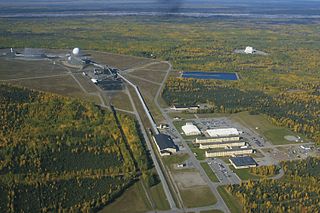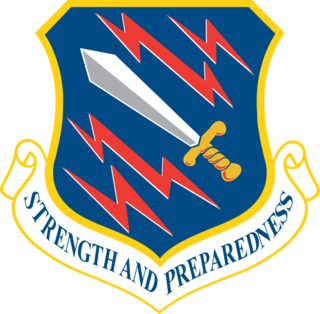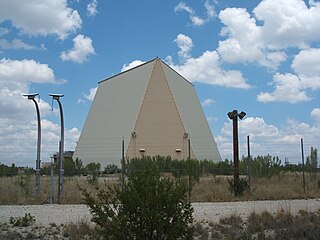
PAVE PAWS is a complex Cold War early warning radar and computer system developed in 1980 to "detect and characterize a sea-launched ballistic missile attack against the United States". The first solid-state phased array deployed used a pair of Raytheon AN/FPS-115 phased array radar sets at each site to cover an azimuth angle of 240 degrees. Two sites were deployed in 1980 at the periphery of the contiguous United States, then two more in 1987–95 as part of the United States Space Surveillance Network. One system was sold to Taiwan and is still in service.

The RCA 474L Ballistic Missile Early Warning System was a United States Air Force Cold War early warning radar, computer, and communications system, for ballistic missile detection. The network of twelve radars, which was constructed beginning in 1958 and became operational in 1961, was built to detect a mass ballistic missile attack launched on northern approaches [for] 15 to 25 minutes' warning time also provided Project Space Track satellite data.

An active electronically scanned array (AESA) is a type of phased array antenna, which is a computer-controlled antenna array in which the beam of radio waves can be electronically steered to point in different directions without moving the antenna. In the AESA, each antenna element is connected to a small solid-state transmit/receive module (TRM) under the control of a computer, which performs the functions of a transmitter and/or receiver for the antenna. This contrasts with a passive electronically scanned array (PESA), in which all the antenna elements are connected to a single transmitter and/or receiver through phase shifters under the control of the computer. AESA's main use is in radar, and these are known as active phased array radar (APAR).

Royal Air Force Fylingdales or more simply RAF Fylingdales is a Royal Air Force station on Snod Hill in the North York Moors, England. Its motto is Vigilamus. It is a radar base and is also part of the Ballistic Missile Early Warning System (BMEWS). As part of intelligence-sharing arrangements between the United States and United Kingdom, data collected at RAF Fylingdales are shared between the two countries. Its primary purpose is to give the British and US governments warning of an impending ballistic missile attack. A secondary role is the detection and tracking of orbiting objects; Fylingdales is part of the United States Space Surveillance Network. As well as its early-warning and space-tracking roles, Fylingdales has a third function – the Satellite Warning Service for the UK. It keeps track of spy satellites used by other countries, so that secret activities in the UK can be carried out when they are not overhead. The armed services, defence manufacturers and research organisations, including universities, take advantage of this facility.

Rome Laboratory is the US "Air Force 'superlab' for command, control, and communications" research and development and is responsible for planning and executing the USAF science and technology program.

The United States Space Surveillance Network (SSN) detects, tracks, catalogs and identifies artificial objects orbiting Earth, e.g. active/inactive satellites, spent rocket bodies, or fragmentation debris. The system is the responsibility of United States Space Command and operated by the United States Space Force.

Clear Space Force Station is a United States Space Force radar station for detecting incoming ICBMs and submarine-launched ballistic missiles to NORAD's command center and to provide Space Surveillance data to the United States Space Force. Clear's AN/FPS-123 Upgraded Early Warning Radar is part of the Solid State Phased Array Radar System (SSPARS) which also includes those at Beale AFB, Cape Cod Space Force Station, RAF Fylingdales and Thule Site J. The "historic property" was one of the Alaska World War II Army Airfields and later a Cold War BMEWS site providing NORAD data to Colorado's BMEWS Central Computer and Display Facility (CC&DF).

Cavalier Space Force Station, North Dakota, is a United States Space Force installation, where the 10th Space Warning Squadron, Space Delta 4, United States Space Force monitors and tracks potential missile launches against North America with the GE AN/FPQ-16 Enhanced Perimeter Acquisition Radar Attack Characterization System (PARCS). The PARCS also monitors and tracks over half of all earth-orbiting objects to enable space situation awareness and space control. In addition to contractors, NORAD has US and Canadian military members assigned to the facility.

The AN/FPS-108 COBRA DANE is a PESA phased array radar installation operated by Raytheon for the United States Space Force at Eareckson Air Station on the island of Shemya, Aleutian Islands, Alaska. The system was built in 1976 and brought online in 1977 for the primary mission of gathering intelligence about Russia's ICBM program in support of verification of the SALT II arms limitation treaty. Its single face 29 m (95 ft) diameter phased array radar antenna 52.7373°N 174.0914°E faces the Kamchatka Peninsula and Russia's Kura Test Range. COBRA DANE operates in the 1215–1400 MHz band.

The 21st Wing is an inactive wing of the United States Air Force.

The 13th Space Warning Squadron (13SWS) is a missile warning unit assigned to the United States Space Force and located at Clear Space Force Station 5 miles (8 km) south of Anderson, Alaska

Eldorado Air Force Station located 35 miles (56 km) south of San Angelo, Texas was one of the four unique AN/FPS-115 PAVE PAWS, early-warning phased-array radar systems. The 8th Space Warning Squadron, 21st Space Wing, Air Force Space Command operated at Eldorado Air Force Station.

Cape Cod Space Force Station is a United States Space Force station located in the northwest corner of Joint Base Cape Cod, United States, on Flatrock Hill in Bourne, Massachusetts. Cape Cod Space Force Station began construction in 1976 as Cape Cod Missile Early Warning Station and was renamed Cape Cod Air Force Station in 1982, before assuming its current name in 2021.

The 7th Space Warning Squadron (SWS) is the premier Space Domain Awareness sensor on the West Coast. The unit was originally established to guard the U.S. West Coast against sea-launched ballistic missiles from the eastern outskirts of Beale Air Force Base approximately 8 miles (13 km) east of Marysville, California. 7 SWS is a geographically separated unit of Space Delta 4.

The United States Air Force's 9th Space Warning Squadron was a United States Air Force missile warning unit located at Robins AFB, Georgia.

The 213th Space Warning Squadron of the Alaska Air National Guard provides early warning of Intercontinental ballistic missiles and Submarine-launched ballistic missiles to the Missile Correlation Center of North American Aerospace Defense Command. The squadron is a geographically separated unit assigned to the 168th Wing at Eielson Air Force Base.

Thule Site J (J-Site) is a United States Space Force (USSF) radar station in Greenland near Pituffik Space Base for missile warning and spacecraft tracking. The northernmost station of the Solid State Phased Array Radar System, the military installation was built as the 1st site of the RCA 474L Ballistic Missile Early Warning System and had 5 of 12 BMEWS radars. The station has the following structures:

The AN/FPQ-16 Perimeter Acquisition Radar Attack Characterization System is a powerful United States Space Force phased-array radar system located in North Dakota. It is the second most powerful phased array radar system in the US Space Force's fleet of missile warning and space surveillance systems, behind the more modern PAVE PAWS phased array radar.

The Missile Warning Center (MWC) is a center that provides missile warning and defense for United States Space Command's Combined Force Space Component Command, incorporating both space-based and terrestrial sensors. The MWC is located at Cheyenne Mountain Space Force Station.

Eglin AFB Site C-6 is a United States Space Force radar station which houses the AN/FPS-85 phased array radar, associated computer processing system(s), and radar control equipment. Commencing operations in 1969, the AN/FPS-85 was the first large phased array radar. The entire radar/computer system is located at a receiver/transmitter building and is supported by the site's power plant, fire station, 2 water wells, and other infrastructure for the system. As part of the US Space Force's Space Surveillance Network its mission is to detect and track spacecraft and other manmade objects in Earth orbit for the Combined Space Operations Center satellite catalogue. With a peak radiated power of 32 megawatts the Space Force claims it is the most powerful radar in the world, and can track a basketball-sized object up to 22,000 nautical miles (41,000 km) from Earth.


















